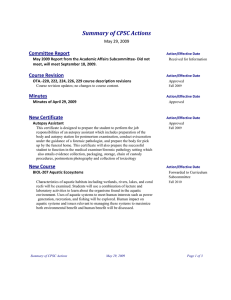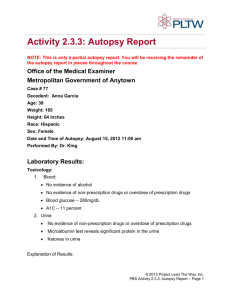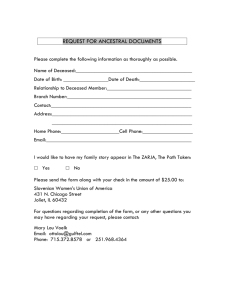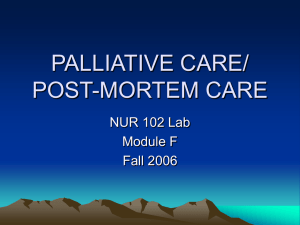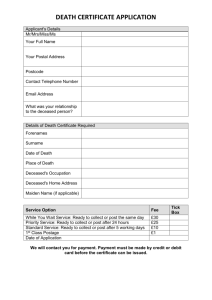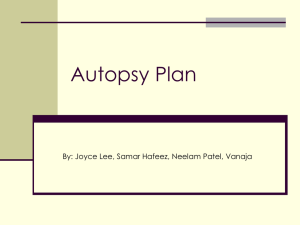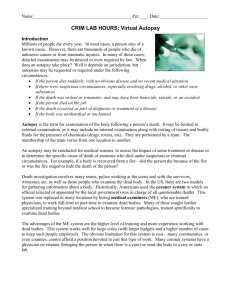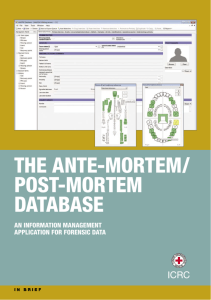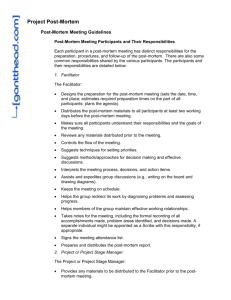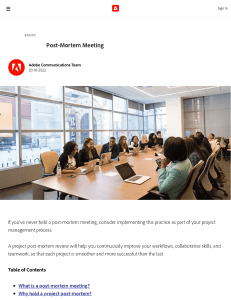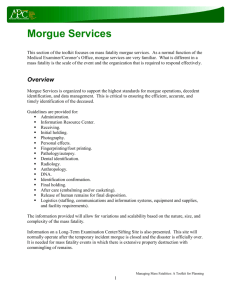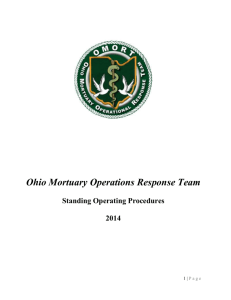Post_Mortem_Care
advertisement
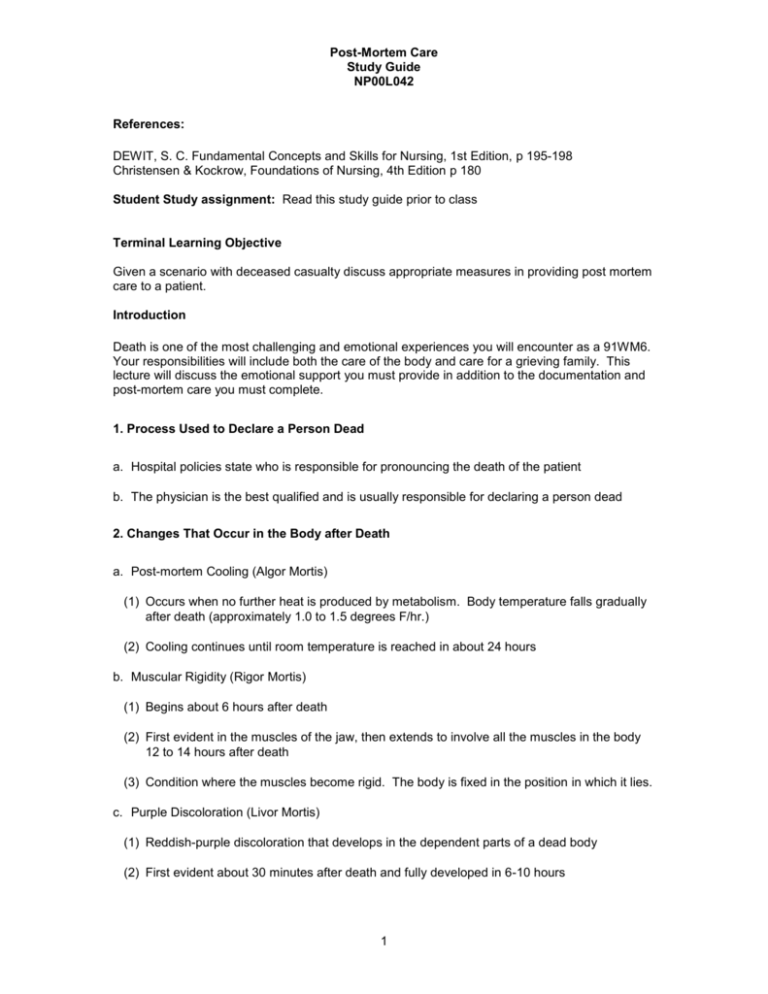
Post-Mortem Care Study Guide NP00L042 References: DEWIT, S. C. Fundamental Concepts and Skills for Nursing, 1st Edition, p 195-198 Christensen & Kockrow, Foundations of Nursing, 4th Edition p 180 Student Study assignment: Read this study guide prior to class Terminal Learning Objective Given a scenario with deceased casualty discuss appropriate measures in providing post mortem care to a patient. Introduction Death is one of the most challenging and emotional experiences you will encounter as a 91WM6. Your responsibilities will include both the care of the body and care for a grieving family. This lecture will discuss the emotional support you must provide in addition to the documentation and post-mortem care you must complete. 1. Process Used to Declare a Person Dead a. Hospital policies state who is responsible for pronouncing the death of the patient b. The physician is the best qualified and is usually responsible for declaring a person dead 2. Changes That Occur in the Body after Death a. Post-mortem Cooling (Algor Mortis) (1) Occurs when no further heat is produced by metabolism. Body temperature falls gradually after death (approximately 1.0 to 1.5 degrees F/hr.) (2) Cooling continues until room temperature is reached in about 24 hours b. Muscular Rigidity (Rigor Mortis) (1) Begins about 6 hours after death (2) First evident in the muscles of the jaw, then extends to involve all the muscles in the body 12 to 14 hours after death (3) Condition where the muscles become rigid. The body is fixed in the position in which it lies. c. Purple Discoloration (Livor Mortis) (1) Reddish-purple discoloration that develops in the dependent parts of a dead body (2) First evident about 30 minutes after death and fully developed in 6-10 hours 1 Post-Mortem Care Study Guide NP00L042 (3) Discoloration is caused by blood flowing passively into the dependent parts of the body d. Decomposition (Putrefaction) (1) The destruction of a dead body by bacteria (2) The rate at which changes develop depends on the environment. Hot, moist conditions favor putrefaction, but cold, dry air delays or prevents it. (3) The body of the deceased should be placed in refrigeration in the morgue as soon as possible (4) It is best not to keep the body on the nursing unit more than one hour (5) Embalming is used as a method of chemically preserving the body. A solution is introduced into the body that kills the bacteria and prevents the rapid decomposition of tissues. 3. Death Certificate a. U.S. laws require that a death certificate be prepared for each person who dies. b. Death certificates are sent to local health departments, which compile statistics from the information c. A physician is usually responsible for declaring a person dead and is required to sign the death certificate 4. Organ Donation and Autopsy a. Patients who express a wish to donate functional organs after death should be provided an organ donor consent card b. The family of a deceased client may decide to donate the client’s organs and should also be provided with information and consent forms c. An autopsy is an examination of the organs and tissue of a human body after death d. The closest surviving family member usually has the authority to consent for an autopsy (1) It is usually the physician’s responsibility to obtain permission for an autopsy (2) The client may have granted permission before his death (3) If the death was caused by accident, suicide, homicide, or illegal therapeutic practice, the coroner must be notified and he will decide if an autopsy is necessary (4) The family’s consent is not needed in these cases e. Many relatives find comfort when they are told that the knowledge gained from an autopsy may contribute to advancements in medical science as well as establish the exact cause of death 2 Post-Mortem Care Study Guide NP00L042 5. Responsibility in Preparing the Body a. Provide privacy for the patient and/or family b. Verify that the patient has died, and has been pronounced dead by the physician c. Notify appropriate persons in the hospital, as well as the clergy, if requested by the family d. Obtain the death pack e. Wear gloves when preparing the body f. Position the body supine in proper alignment, close the eyelids, and place a pillow under the head. If the eyes are to be donated, place a small ice pack on each eye. g. Change all dressings; if appropriate, remove jewelry and eyeglasses and place with personal belongings, and replace dentures, if possible h. Bathe the body (1) Using plain water, wash the areas of the body that may be soiled with blood, feces, or emesis (2) If drainage occurs around the rectum, urethra or vagina, place a gauze 4 X 4 over each opening and secure it with tape to prevent further soiling i. Arrange the hair neatly j. Care of drainage and other tubes (1) If there is to be an autopsy, the tubes are generally left in the body (2) Remove the drainage bottles or bags from the tubes and fold the tubes over twice; secure each with a rubber band to avoid leakage (3) Make sure you deflate the balloon tips so as not to injure the body tissues upon removal k. Apply a clean patient gown and clean bed linen if the family will be viewing the body; leave the head uncovered and have the room arranged neatly l. Prepare the family before viewing the body: offer support and your physical presence if desired, during their visit, and assist them with funeral arrangements, if necessary m. Identify and assemble the patient's personal belongings for the family; complete a full inventory of the patient's belongings n. Attach 3 forms of identification. Two tags are placed on the body (usually the great toe and the wrist). A third tag is placed on the shroud or zippered bag. o. You may need to tie a bandage lightly under the jaw and up around the head to keep the jaw closed 3 Post-Mortem Care Study Guide NP00L042 p. Lightly bandage the wrists together, criss- crossed over the abdomen to prevent the arms from falling off the stretcher when the body is being moved to the morgue q. Place the body within the shroud or zippered bag r. Transport the body to the morgue (1) Place the body on a stretcher and secure it with straps s. Record the procedure before the body leaves the nursing unit (1) Record the time and date body was taken to the morgue or by the undertaker (2) If valuables were placed in safekeeping, indicate this in writing (3) If valuables were given to the family or friends, record name of the person(s) to whom they were given, their relationship to the deceased, and the time and date (4) Have a co-worker who witnessed this action co-sign with you in the notes 6. Role in Caring for the Family of the Deceased Client a. After death, the soldier medic must continue to provide care for the family of the deceased client b. Listen to the family’s expression of grief and loss c. Allow family members to see the client’s body. This will help them to accept the death fully. d. Provide a private place for the family to grieve and make necessary arrangements e. Contact the chaplain if the family requests 7. Learning Step / Activity 7. Deaths on the Battlefield a. On the battlefield when KIA's are identified a spot report is generated identifying the location of the remains so that when the battle is over the remains can be recovered and turned over to mortuary affairs. b. It is standard to use a 10 digit grid coordinate (1) 10 Digit Grid coordinate will identify a 1 square meter location within a grid square for the location of the body (2) A global positioning system (GPS) can also be used to document the location of a body NOTE: The transportation and disposition of remains is a quartermaster function. Air and ground ambulance personnel do not clear the battlefield of remains nor do they carry remains in their dedicated medical vehicles or aircrafts. Medical units do not accept remains or provide temporary morgues in which to hold remains for other units until they can be transffered to mortuary affairs sites/personnel. 4 Post-Mortem Care Study Guide NP00L042 NOTE: The only remains that a medical unit handles are those of its own unit members or of patients who are dead on arrival (DOA) or who died of wounds (DOW) while in their care. Whenever a medical unit must establish a temporary morgue, it should be established out of sight of the triage and treatment areas. This area can be established behind a natural barrier, such as a stand of trees or it can be set off by using a tentage and tarpaulins. This is not an actual morgue, as it has neither the required equipment nor is it staffed; it is only a temporary holding area. SUMMARY Death, for everyone involved, is a trying experience. It is emotionally taxing to go through the stages of death and the preparations for burial. The soldier medic can be of great help and comfort to the patient and his family. 5

